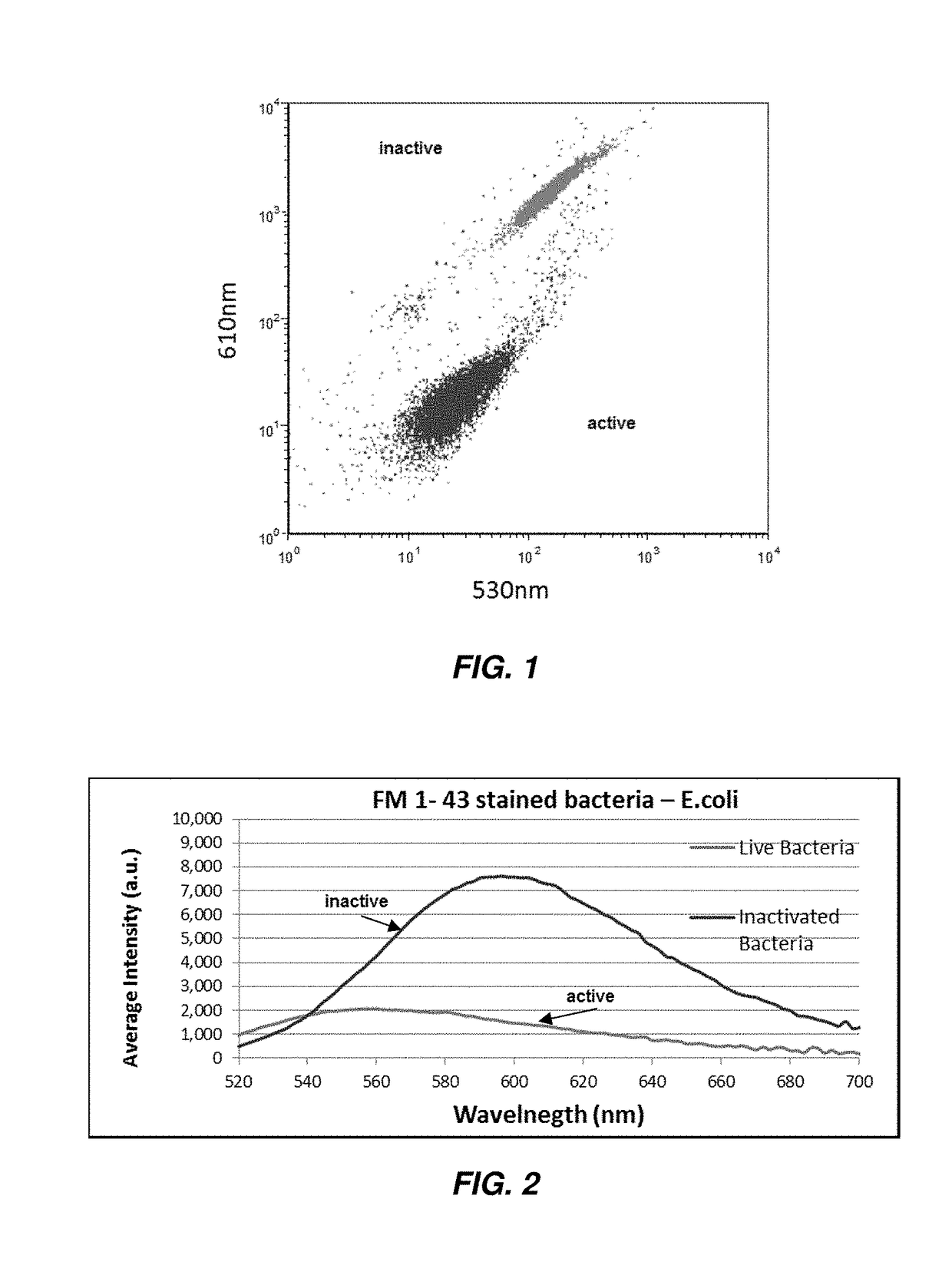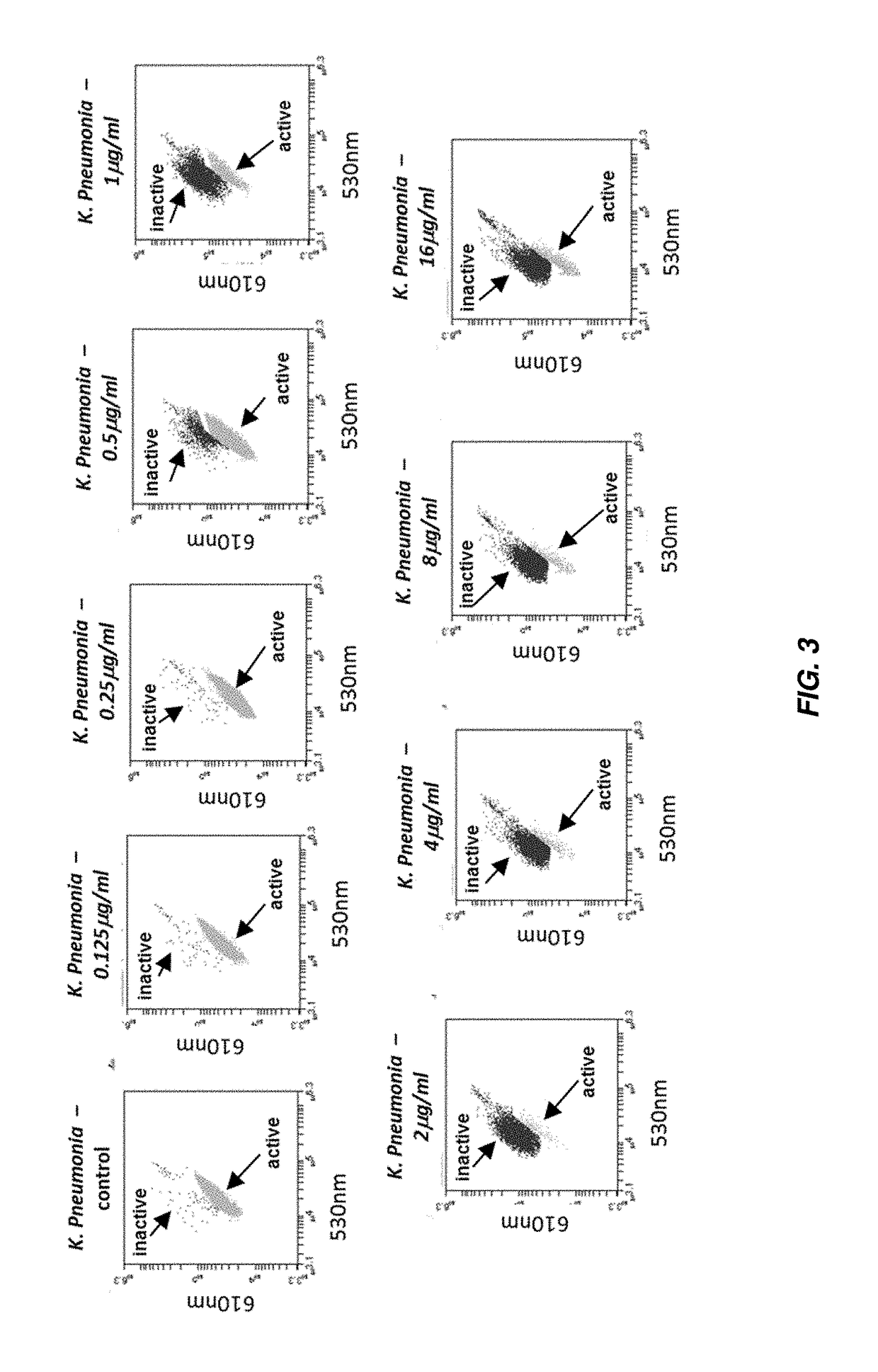Rapid Antibiotic Susceptibility Test Using Membrane Fluorescence Staining and Spectral Intensity Ratio Improved by Flow Cytometry Dead to Live Population Ratio
a technology of flow cytometry and susceptibility test, which is applied in the field of dead to live population ratio of rapid antibiotic susceptibility test using membrane fluorescence staining and spectral intensity ratio improvement by flow cytometry, can solve the problems of inability to grow on the spot containing the antibiotic, long process, and inability to meet the requirements of antimicrobial susceptibility testing techniques, etc., to achieve clear step function
- Summary
- Abstract
- Description
- Claims
- Application Information
AI Technical Summary
Benefits of technology
Problems solved by technology
Method used
Image
Examples
example 1
[0116]In this example, a rapid method for AST and MIC determination directly from blood culture with a turnaround time of 15 mins after 2-4 hours of antibiotics exposure is presented.
[0117]Materials and Methods: In general, the method includes; blood culture centrifugation, bacterial antimicrobial exposure for 2 to 4 hours, bacteria staining with a single fluorescence dye followed by a flow cytometric measurement, and mathematical analysis.
[0118]Sample Preparation—Macro Dilution Method
[0119]31 positive blood cultures were obtained from Sheba Medical Center (Ramat-Gan, Israel) and tested for antimicrobial susceptibility with gentamicin and ampicillin antibiotics (Sigma-Aldrich, USA). A total of 62 positive blood samples-antibiotics combinations were tested.[0120]a) Positive blood samples were received from Sheba Medical Center, 2 ml of each sample were centrifuged for 15 min at 24×g and Supernatants were diluted 1:1000 with Cation-Adjusted Mueller Hinton Broth (CAMHB).[0121]b) Antimi...
example 2
[0143]In this Example, a rapid method for AST and MIC determination from clinical isolates.
[0144]Materials and Methods: Our method includes bacterial antimicrobial treatment for 2 to 4 hours, bacteria staining with a single fluorescence dye followed by a flow cytometric measurement, and mathematical analysis. The following paragraphs describe the method in details.
[0145]Sample Preparation—Macro Dilution Method:
[0146]Thirty (30) clinical isolates of E. coli, K. pneumoniae, E. cloacae, P. mirabilis, and C. freundii, purchased from JMI Labs (IA, USA), were tested for antimicrobial susceptibility with gentamicin, ampicillin, and ciprofloxacin antibiotics (Sigma-Aldrich, USA). A total of 90 isolates-antibiotics combinations were tested.[0147]a) All strains were cultured onto 5% sheep blood agar (Hylabs, Israel), following overnight incubation, colonies were harvested and suspended in Phosphate Buffer Saline (PBS, Sigma-Aldrich). Each bacterial solution was then adjusted to 0.5 McFarland ...
example 3
[0170]In this Example, E. coli bacteria samples were incubated with Gentamycin in series dilution from 0 to 32 μgr / ml for 120 minutes. Post incubation the samples were stained with the dye FM1-43 and immediately measured by flow cytometry analysis on light scatter analysis for gating the bacteria and with fluorescence filters: λ1=530 / 30 and λ2=616 / 16 nm to analyze the SIR. Moreover gating of the Dead and live bacteria were determined.
[0171]In FIG. 14A one can observe the representative fluorescence dot plot of live E. coli after 120 minutes incubation with no antimicrobial agent. There is one major population that are presenting the live bacteria, 98.2% (labeled as “live”). In FIG. 14B the bacteria were incubated with sub-MIC (1 μg / ml) of gentamycin, were still the major population are the black dots, 95.2% with slightly increment of the dead population to 4.6% (labeled as “dead”). In FIG. 14C the bacteria were incubated with over-MIC of gentamycin (8 μg / ml), were live population de...
PUM
| Property | Measurement | Unit |
|---|---|---|
| wavelength | aaaaa | aaaaa |
| wavelength | aaaaa | aaaaa |
| wavelength | aaaaa | aaaaa |
Abstract
Description
Claims
Application Information
 Login to View More
Login to View More - R&D
- Intellectual Property
- Life Sciences
- Materials
- Tech Scout
- Unparalleled Data Quality
- Higher Quality Content
- 60% Fewer Hallucinations
Browse by: Latest US Patents, China's latest patents, Technical Efficacy Thesaurus, Application Domain, Technology Topic, Popular Technical Reports.
© 2025 PatSnap. All rights reserved.Legal|Privacy policy|Modern Slavery Act Transparency Statement|Sitemap|About US| Contact US: help@patsnap.com



